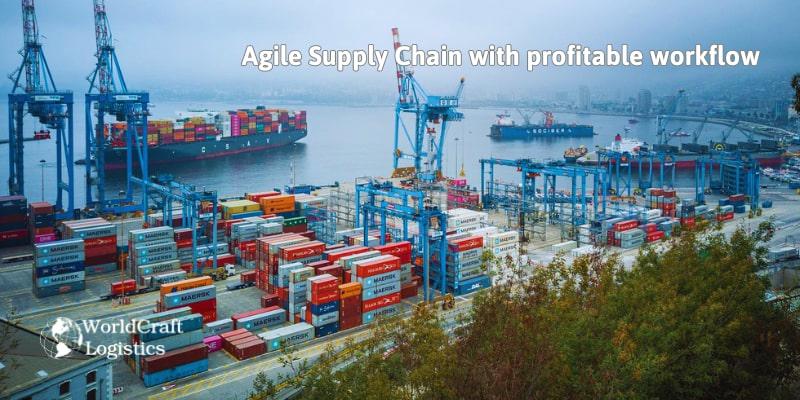
Starting June 1st, 2023 Our warehouse fee will be $0.65/cubic foot per month
In effort to lower the warehouse storage fee during inflation, we have went narrow aisle racking.This construction took us four months but the project is finally completed. With narrow aisle racking, we are able to drop storage by 24%.We as partners will go through this inflation together.
02/04/2024
Data demonstrates that organizations that employ supply chain agility outperform their rivals in terms of customer satisfaction. Some brands maintain inventory levels that rotate, on average, 23 days more quickly than less adaptable rivals. How did these businesses reach these metrics? combining integrative software that connects key corporate activities with strategic supply chain agility models.

An organization's capacity to adapt easily to market changes is referred to as supply chain agility. These changes are extensive and interconnected, affecting a variety of factors, including shifts in consumer tastes, market and economic volatility, and disruption from competitors, to mention a few.
In order to fulfill internal KPIs, daily operations and procedures are not being changed by supply chain agility. But increasing the agility of the manufacturing supply chain will force internal process changes. It typically entails implementing new technology, data management, and service contracts with providers.
The objective is to keep a supply chain that is adaptable, fluid, and knowledgeable so that they can quickly handle any changes that might occur—whether they are favorable or unfavorable.
Agile supply chains that are successful require:
Acknowledging that your supply chain is shaped by external influences However stable things may be at the moment, logistics
Examining the value chain segments most impacted by industrial disruption
Improving the value chain's pain points with the incorporation of more proactive technology and procedures
Continuing to monitor and analyze new processes, find ways to reduce production costs, work together across functional lines, and tweak procedures as necessary.

Organizations have different supply networks from one another. There is no one strategy that works for all businesses; rather, there should be a driving vision for how your company should function. However, there are several essential elements within that Vision. When compared to late adopters and those that don't take the traits seriously, businesses that exhibit these characteristics fall into the category of the former.

Any aggravations or disruptions in the sector, whether they are already happening or are just around the corner, can be simply handled by professionals. Decisions are based on current, objective data in quick, intelligent operational channels that are contextualized and made clear to everyone in the organization, not just the executive suite.
The expectations of the market, vendors, and customers are considerably better met via supply chains. Additionally, they are adaptable in how these modifications influence the internal business requirements or new strategic priorities. Organizations have the concepts and resources in place to quickly coordinate processed weeks and then track the effects of those changes down the chain in real-time. Next phase reports are prepared as data is gathered at each stage to meet adaptive needs in the future.
Cost savings are not the primary goal of an agile supply chain, but they are undoubtedly a positive side consequence. Businesses with more fluid and adaptable procedures are better able to minimize losses when there are stock or sales fluctuations. Additionally, these firms are much more adept in foreseeing any shortages or breaks in the supply chain. Additionally, customers can see more of the present process and product waste, including too much safety stock.

You may develop a production environment that is leaner, faster, and smarter by combining decreased waste, quicker decision-making, continuous data review, and greater cross-departmental communication. This is a natural way to increase profit. Implementing a more agile supply chain is crucial for businesses today that want to remain in operation in the future, even though it can be easier said than done.
It's crucial to comprehend the various factors that affect agility in order to create an agile supply chain. Here are the five essential components of a flexible supply chain.

Alertness is the capacity to see hazards, opportunities, and changes swiftly.
Online merchants need to be able to recognize and respond to changes in the supply chain, whether they are positive or negative, without delay. This entails anticipating changes in the market, keeping an eye on the industry as a whole, and even how competitors are approaching the market.
Being vigilant prevents an online firm from missing out on sales or from selling out-of-date products. This may indicate that it's time to stop selling certain of your product line's offerings or look for ways to enhance your delivery tactics.
You are more likely to develop consumer loyalty and consistently hit profit targets if you offer in-demand products and quick delivery.
While being "alert" enables a corporation to take preventative action, being "accessible" refers to how much supply chain visibility you have. Additionally, real-time data is what determines how much visibility you have.
For instance, it is simpler to estimate demand, manage inventory effectively, and identify methods to enhance the fulfillment and shipping process when you have access to real-time data and insights into historical data.
The term "decisiveness" describes the capacity to choose wisely. The more your supply chain expands, the more challenging it becomes to decide effectively. However, using supply chain technology that continuously records data will help you be proactive and make the best decisions possible based on the data.
A merchant dashboard with an advanced data and analytics reporting tool, for instance, is a feature of WorldCraft's technology that offers visual insights to assist with everything from year-end inventory reporting to better supply chain management and decision-making. Without ever slowing down operations, you can simply capture and retrieve data, optimize supply chain planning, and more with the correct technology in place.
Swiftness is the capacity to carry out changes effectively. Being able to recognize improvements and areas for change is one thing; being able to put those changes into action swiftly is quite another. Make sure to provide room for supply chain optimization when you establish your supply chain. By doing this, you may concentrate on gradually expanding into more fulfillment locations or diversifying your carrier network while reducing inefficiencies and lowering total expenses.
Flexibility is the capacity to change supply chain activities in response to required adjustments and choices.
For all supply chains, being able to modify and alter operational methods effectively is crucial since it increases flexibility and promotes growth.
Working with several manufacturers or suppliers, for instance, can help you fulfill client demand, introduce new product items based on popularity, and make sure there is always enough inventory on hand.
Partnering with a 3PL like WorldCraft, which offers operational infrastructure and technology to easily grow into new channels, territories, and fulfillment center locations, is another method to maintain flexibility.
You can simply grow your supply chain with the proper 3PL on your side rather than having to make time-consuming and expensive investments in your own infrastructure and technology.
Despite unavoidable hiccups, having the correct technology and procedures in place helps keep customers happy and an online business financially secure. All industries have long recognized the value of an agile business strategy, but e-commerce is particularly dependent on agility to satisfy customer expectations and reduce costs. The importance of supply chain agility for e-commerce is outlined below.

In spite of changes in order volume, one of the major advantages of having an agile supply chain is that it allows you to continuously meet consumer demand for quick, economical shipping.
But it takes conscious supply chain strategy and execution to keep up with the constantly shifting demands of the market.
You must think about various strategies to guarantee that you can meet client expectations despite probable disruptions or unexpected changes in market demand if you want to achieve supply chain agility.
Examples of how to satisfy client demand while remaining flexible include:
Storing inventory across multiple distribution facilities
Incorporating technology and automation into logistics
Collaborating with several manufacturers
Utilizing both national and local parcel carriers
Finding strategies to reduce the cost of logistics is one of the most crucial aspects of running a successful e-commerce firm. Some examples include:
Labor Costs for Warehousing and Storage
Order completion
Inventory control
Shipping
There are a number of strategies to cut costs and keep your company flexible, including optimizing inventory based on demand and sourcing products locally to cut transportation costs.
Agility is established by supply chain efficiency, so it's critical to continually look for ways to make your supply chain leaner.
Processes in the supply chain can be streamlined to increase productivity, decrease human error, and ultimately save time and money.
Implementing automation to eliminate manual effort is a successful method for streamlining procedures.
Even though time-consuming tasks like order processing and automated shipping cannot completely replace the requirement for human labor, they can be automated to improve your business operations and boost productivity.
Some companies even automate their warehouses using techniques and technologies they have developed internally.
Customers anticipate quick, dependable, and regular shipping.
With the potential to quickly fill orders across numerous channels and geographically increase customer reach, on-demand logistics has grown in popularity as a result of these expectations.
A strong distribution network, adaptable fulfillment options, and cutting-edge technology that facilitates speed and improves order accuracy are necessary to develop an agile supply chain that meets customer expectations.
Agility in the supply chain is the capacity to deal with erratic changes in demand and supply as well as the ability to quickly adjust to the shifting demands of the market and customers.
A supply chain that is agile may quickly adjust in reaction to sudden changes or quick changes in supply and demand. It can quickly adjust to changing market conditions and quickly align its activities with them.

By expanding your network of manufacturers and suppliers, encouraging productive communication across departments and trading partners, and automating supply chain data collecting and analytics procedures, you may develop an agile supply chain. Utilizing digital networking technology and multienterprise work management software, which promote real-time information exchange, increase end-to-end supply chain visibility, and support collaborative workflows that enable quicker issue resolution, is one of the best ways to increase supply chain agility.
When it comes to the supply chain, agility is defined as the following: alertness, or the capacity to recognize and foresee potential change and potential opportunities; accessibility, or the capacity to obtain accurate and pertinent data about the supply chain as a whole; decisiveness, or the capacity to choose an appropriate course of action in response to change; speed, or the capacity to complete tasks in the shortest amount of time; and flexibility, or the capacity to modify tactics, strategies, and other operational elements.
SEO
Digital Marketing/SEO Specialist
Simon Mang is an SEO and Digital Marketing expert at Wordcraft Logistics. With many years of experience in the field of digital marketing, he has shaped and built strategies to effectively promote Wordcraft Logistics' online presence. With a deep understanding of the logistics industry, I have shared more than 500 specialized articles on many different topics.

Education
01/05/2025

Education
02/18/2025

Education
01/01/2024

Education
08/28/2024

Education
11/13/2023